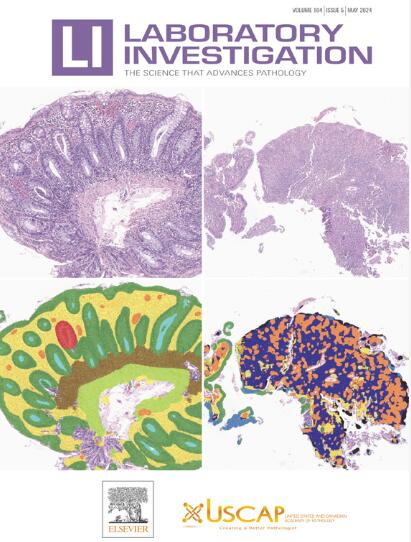胶质瘤 DNA 甲基化分析:分析前变量评估
IF 5.1
2区 医学
Q1 MEDICINE, RESEARCH & EXPERIMENTAL
引用次数: 0
摘要
精准肿瘤学由生物标记物驱动。多形性胶质母细胞瘤(GBM)是最常见的恶性成人原发性脑肿瘤,O6-甲基鸟嘌呤-DNA 甲基转移酶(MGMT)基因启动子甲基化是重要的预后和治疗临床生物标志物。生物样本的储存、固定、取样和处理等分析前步骤耗时较长,是造成数据不可重复的原因,而且所有这些分析前变量都会受到肿瘤内 MGMT 启动子甲基化异质性的影响。为了评估分析前变量对 GBM DNA 甲基化的影响,研究人员使用了组织储存/取样(CryoGrid)、样本制备多功能超声仪(PIXUL)和 5-甲基胞嘧啶(5mC)DNA 免疫沉淀(Matrix MeDIP-qPCR/seq)平台。通过甲基化特异性 PCR(MS-PCR)对 MeDIP-qPCR 检测的 MGMT 启动子甲基化状态进行了验证。冷冻样本对和福尔马林固定石蜡包埋样本对的 MGMT 启动子甲基化水平没有统计学差异,这证实了用福尔马林固定石蜡包埋样本对进行 MGMT 启动子甲基化分析的可靠性。温暖的体外缺血(37oC 下长达 4 小时)和 3 次重复样本解冻和冷冻不会对 MGMT 启动子、外显子和增强子区域的 5mC 产生统计学影响,这表明 DNA 甲基化不受研究和临床环境中可能遇到的样本处理条件常见变化的影响。26%-34%的标本显示出肿瘤内 MGMT DNA 启动子甲基化的异质性。这些数据表明,样本固定、缺血持续时间和温度以及 DNA 甲基化检测技术的变化对 MGMT 启动子甲基化评估没有显著的统计学影响。然而,肿瘤内甲基化的异质性强调了在评估 MGMT 启动子甲基化状态时在不同 GBM 地理肿瘤部位进行多次活检的价值。矩阵-MeDIP-seq分析显示,MGMT启动子甲基化状态与其他不同的甲基化基因组位点(如HOXA和lncRNAs)聚集在一起,而这些位点对上述分析前条件的变化具有弹性。这些观察结果为开发基于更精细数据的表观遗传 GBM 生物标记物提供了新的机遇。在这方面,高通量 CryoGrid-PIXUL-Matrix 工具箱可能会有所帮助。本文章由计算机程序翻译,如有差异,请以英文原文为准。
Analysis of DNA Methylation in Gliomas: Assessment of Preanalytical Variables
Precision oncology is driven by biomarkers. For glioblastoma multiforme (GBM), the most common malignant adult primary brain tumor, O6-methylguanine-DNA methyltransferase (MGMT) gene promoter methylation is an important prognostic and treatment clinical biomarker. Time-consuming preanalytical steps such as biospecimen storage, fixation, sampling, and processing are sources of data irreproducibility, and all these preanalytical variables are confounded by intratumor heterogeneity of MGMT promoter methylation. To assess the effect of preanalytical variables on GBM DNA methylation, tissue storage/sampling (CryoGrid), sample preparation multisonicator (PIXUL), and 5-methylcytosine DNA immunoprecipitation (Matrix-MeDIP-qPCR/seq) platforms were used. MGMT promoter methylation status assayed by MeDIP-qPCR was validated with methylation-specific polymerase chain reaction. MGMT promoter methylation levels in frozen and formalin-fixed paraffin-embedded sample pairs were not statistically different, confirming the reliability of formalin-fixed paraffin-embedded for MGMT promoter methylation analysis. Warm ex vivo ischemia (up to 4 hours at 37 °C) and 3 cycles of repeated sample thawing and freezing did not statistically impact 5-methylcytosine at MGMT promoter, exon, and enhancer regions, indicating the resistance of DNA methylation to common variations in sample processing conditions that might be encountered in research and clinical settings. Twenty-six percent to 34% of specimens exhibited intratumor heterogeneity in the MGMT DNA promoter methylation. These data demonstrate that variations in sample fixation, ischemia duration and temperature, and DNA methylation assay technique do not have a statistically significant impact on MGMT promoter methylation assessment. However, intratumor methylation heterogeneity underscores the value of multiple biopsies at different GBM geographic tumor sites in the evaluation of MGMT promoter methylation status. Matrix-MeDIP-seq analysis revealed that MGMT promoter methylation status clustered with other differentially methylated genomic loci (eg, HOXA and lncRNAs) that are resilient to variation in the above preanalytical conditions. These observations offer new opportunities to develop more granular data-based epigenetic GBM biomarkers. In this regard, the high-throughput CryoGrid-PIXUL-Matrix toolbox could be useful.
求助全文
通过发布文献求助,成功后即可免费获取论文全文。
去求助
来源期刊

Laboratory Investigation
医学-病理学
CiteScore
8.30
自引率
0.00%
发文量
125
审稿时长
2 months
期刊介绍:
Laboratory Investigation is an international journal owned by the United States and Canadian Academy of Pathology. Laboratory Investigation offers prompt publication of high-quality original research in all biomedical disciplines relating to the understanding of human disease and the application of new methods to the diagnosis of disease. Both human and experimental studies are welcome.
 求助内容:
求助内容: 应助结果提醒方式:
应助结果提醒方式:


